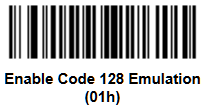MicroPDF is a multi-row 2D barcode that is based on the PDF417 barcode symbology. Most businesses prefer it for small area applications because of its compactness.
Often, manufacturers use MicroPDF along the PDF417 to label their products. It encodes up to 150 alphanumeric characters, using a limited set of symbols, which use a fixed level of error correction.
It’s used to set the MicroPDF width by specifying the data column number (1-4), and the variable number of rows.
This is the ratio of the width (X) to height (Y), which is combined with the Mode to get the MicroPDF barcode size.

Used to transmit data using Code 128 symbology, using the following settings:
C0 – A Barcode reader transmits the data as encoded.
C2 – A single alpha character or first 2 digits is the Application Indicator preceded by an FNC1 character.
Emulation Off – Default setting that does not use emulation.
Unlinked C1 – Means the data is not linked to the MicroPDF symbol.
Linked C1 – The linear symbology under the MicroPDF barcode is linked to its data. Therefore, the barcode reader must find the linear symbol and decode it, within its field of view.
Used to trigger the barcode reader to read the menu symbols (Barcode Initialization Symbols), if the reader supports them.
It’s used to disable industry-specific header and trailer abbreviation. That reduces the number of symbols needed to encode data, to create a compact MicroPDF barcode.
See how you can read a MicroPDF Barcode with ByteScout Barcode Reader freeware below.
You can download the MicroPDF Barcode reader from our site, and then install it on your computer.
After you have installed your MicroPDF Barcode, you can launch it using its desktop shortcut, or from the Start menu.
Once the ByteScout Barcode reader is open, you need to upload the barcode image, for the reader to scan it. You can do that in the following ways:
With the MicroPDF barcode uploaded, you can click on MicroPDF to read the barcode. Once the scan is complete, you can export the results in CSV, TXT, XML, or JSON formats.
That is all you need to do to scan your MicroPDF using our MicroPDF barcode reader.